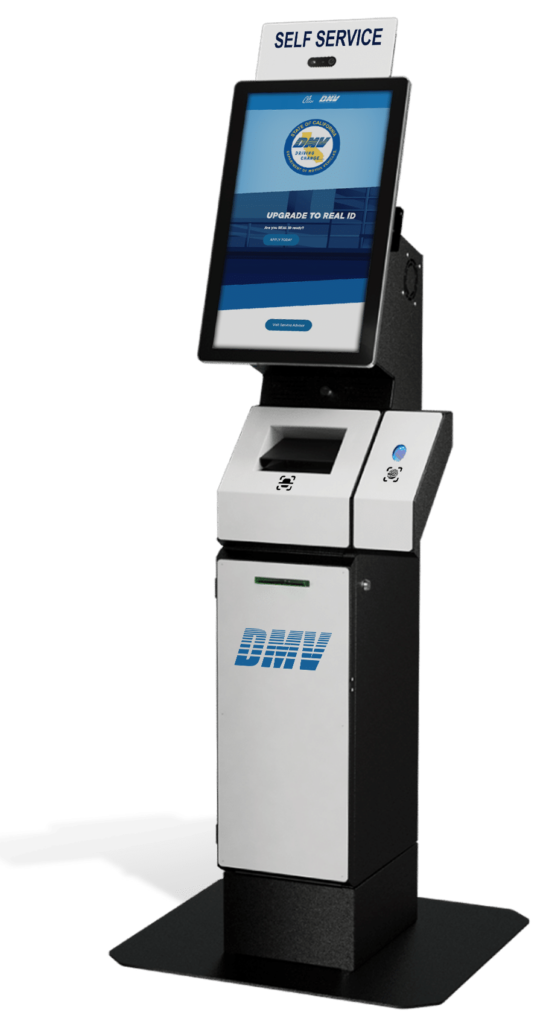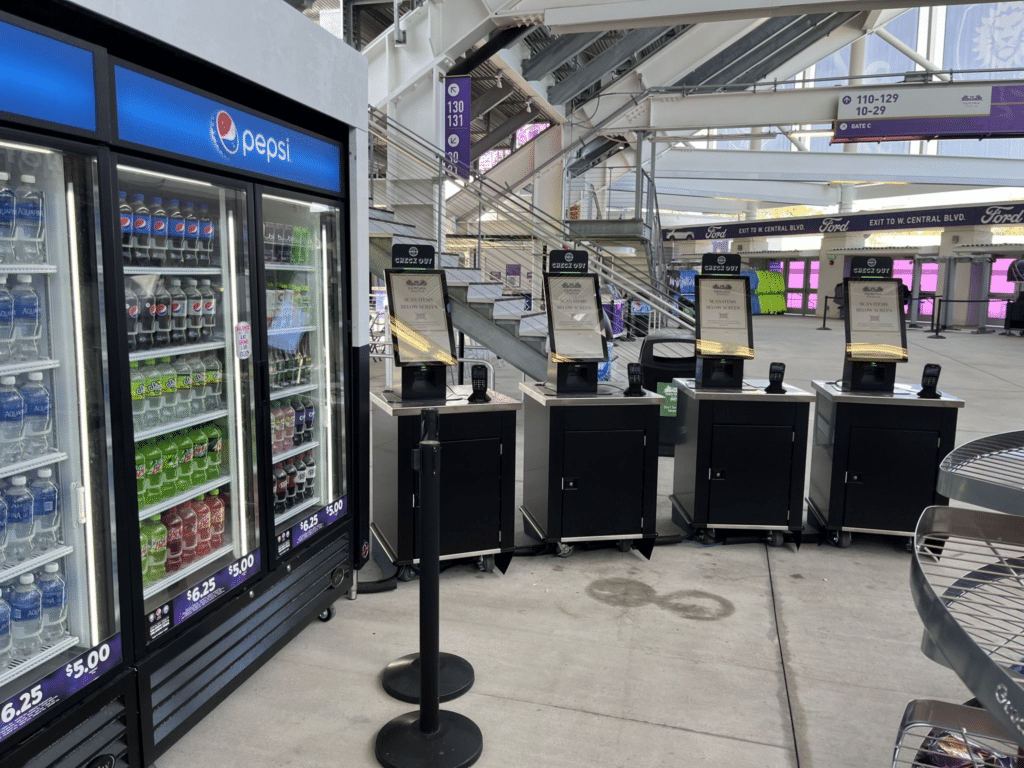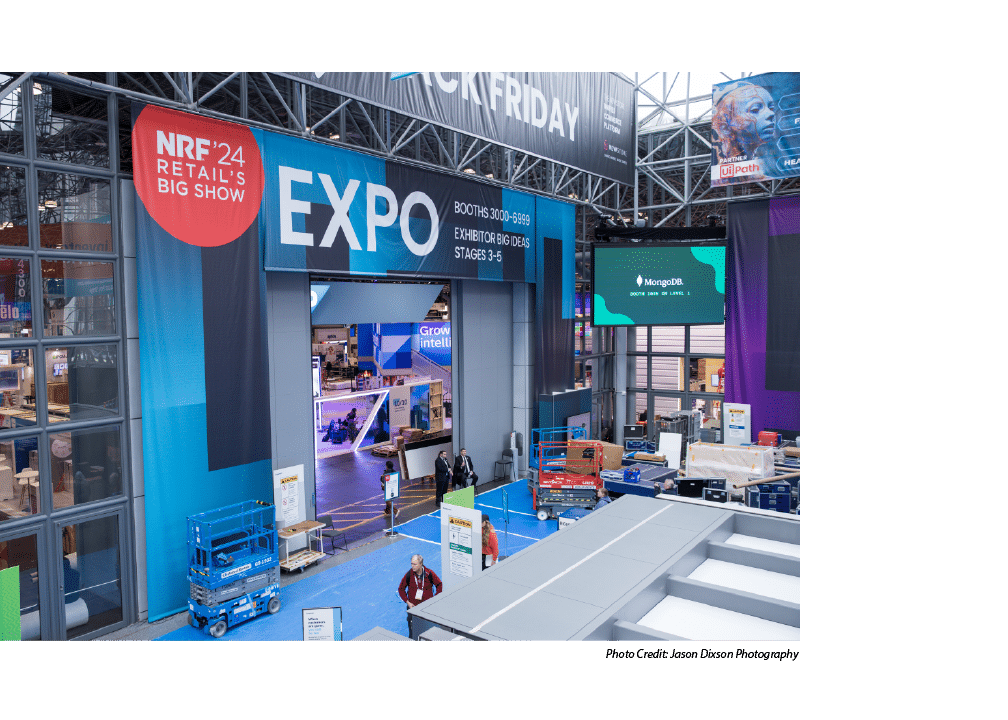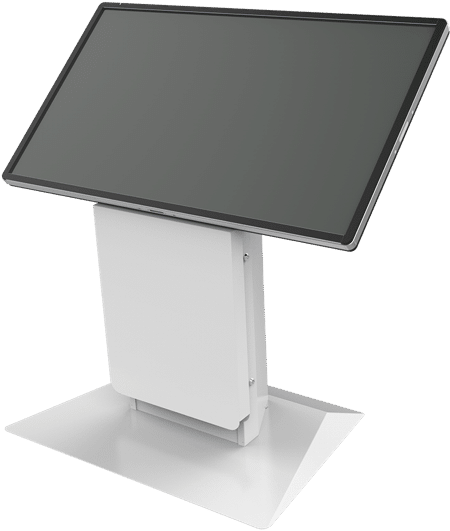Retail’s Big Show not only showcased the latest innovations but also served as a platform for ideas that redefine customer engagement and operational efficiency. Amidst the dazzling technology and thousands of vendors, the next wave of trends in self-service hold significance for any business eager to navigate the digital age. What’s important to note is that these takeaways transcend the retail sector, offering valuable lessons for any industry with frontline customer interaction.
As we delve into the core themes from NRF 2024, it’s clear that the future of self-service and customer engagement is bright, challenging, and ripe with opportunities for those ready to continue their digital transformation.
Themes from NRF 2024
Human-Centered Design
When we talk about self-service kiosks, it’s important to think about the people who will use them. Imagine you’re creating a new kiosk for buying tickets or a self-checkout system for buying bottled drinks at a stadium. You want to make sure it’s easy and even fun for everyone to use.
The big idea is simple: when we make technology, we should always think about the people who will use it. Will it be easy for them to use? Will it make them happy or frustrated? We’re trying to make sure that technology helps people, not make things harder for them. Anything that introduces any kind of friction can make a potential buyer reconsider.
Why Does It Matter?
Personalization: People like it when technology knows what they need. If a machine or a website can remember your name or what you like, it makes you feel special, just like a good friend who knows your coffee order.
Creating a Connection: We also want to make technology that makes people feel good. It’s nice when a machine says “hello” or “thank you,” just like a person would. It makes us feel like we’re not just talking to a robot.
Simplicity: Everyone should be able to use technology, even if they’re not good with computers or gadgets. We try to make things easy to understand so nobody feels left out or frustrated.
Always Getting Better: People change, and what they need from technology changes too. That’s why we keep asking for feedback and making improvements. It’s like how your favorite video game gets updates to make it even better.
In short, when we make technology, we’re trying to make sure it feels more like a helpful friend and less like a complicated puzzle.
Advanced Technology Integration
At NRF 2024, the retail and self-service industries witnessed an impressive showcase of innovation. Among the trends in self-service, Artificial Intelligence (AI), the Internet of Things (IoT), and robotics stood out for their potential to revolutionize how kiosks operate and interact with users.
Artificial Intelligence (AI)
AI has the potential to transform self-service kiosks into smart assistants capable of understanding and predicting customer needs. From personalized recommendations to store analytics and insights, and voice recognition, AI enables kiosks to provide a more intuitive and engaging user experience. Imagine walking up to a kiosk that recognizes your preferences from past interactions and suggests products or services you might like — that’s AI in action.
The Internet of Things (IoT)
IoT technology allows kiosks to connect and communicate with other devices and systems, creating a seamless and integrated service network. For example, a self-service kiosk in a grocery store could communicate with inventory systems to provide real-time stock updates or with smart shopping carts to streamline the checkout process. This interconnectedness enhances operational efficiency and elevates the customer experience by ensuring that everything customers need is always at their fingertips.
Robotics
Robotics integration into self-service kiosks introduces an element of physical interaction that was previously limited to human-only tasks. Robots can now handle inventory management, product delivery, and even prepare food orders in conjunction with kiosks. This not only speeds up the service but also adds a novel and engaging element to the customer experience, making every visit to a kiosk a unique encounter.
Enhancing Functionality and User Experience
The integration of these advanced technologies into self-service kiosks is about improving how these kiosks function and serve users. AI, IoT, and robotics work together to make kiosks more responsive, efficient, and capable of delivering personalized services that meet the high expectations of today’s consumers.
Omnichannel Strategies: Integration with Mobile and Digital Platforms
Omnichannel strategies are all about creating a unified customer experience, whether the customer is shopping online from a mobile device, a laptop, or in a brick-and-mortar store. This approach allows customers to start their journey on one platform and seamlessly continue on another. For example, a customer might research a product on their smartphone, order it via a self-service kiosk, and choose to pick it up in-store or have it delivered to their home. This seamless integration across different channels enhances the customer journey, making it more fluid and intuitive.
The Role of Mobile Integration
Mobile integration is crucial for accessibility and convenience, offering customers the flexibility to interact with services on-the-go. With smartphones becoming an integral part of our lives, businesses are leveraging mobile apps and responsive websites to extend their reach and improve service delivery. This integration allows for a variety of features, such as:
Mobile Payments: Enabling customers to pay for services through mobile wallets or apps directly at the kiosk.
Personalization: Using data from mobile interactions to offer personalized recommendations and services on kiosks.
Loyalty Programs: Allowing customers to access and redeem loyalty points through both kiosks and mobile devices, fostering a sense of loyalty and encouraging repeat business.
Real-Time Notifications: Sending alerts and updates to customers’ mobile devices, keeping them informed about their orders or services initiated through kiosks.
The integration of self-service kiosks with mobile and digital platforms significantly enhances service delivery by providing real-time data synchronization, personalized customer interactions, and the convenience of mobile access. It empowers customers to control their experiences while providing businesses with valuable insights into customer preferences and behaviors. This, in turn, enables businesses to tailor their offerings, improve service efficiency, and ultimately drive customer satisfaction.
Innovative Payment Solutions: The Next Frontier
Payment technologies are rapidly transforming retail and self-service, marking a shift towards more secure, efficient, and user-friendly transaction methods. Among these innovations, biometric verification and contactless transactions stand out.
Biometric Verification
Biometric verification uses unique physical or behavioral characteristics, such as fingerprints, facial recognition, or voice patterns, for identification and authentication. This technology brings a new level of security to transactions, as biometric data is much harder to forge, or steal compared to traditional PINs or passwords. Moreover, it simplifies the payment process, offering a swift and seamless experience for users. Customers no longer need to remember pin codes or carry physical cards; a simple fingerprint or facial scan suffices to authenticate a transaction.
The Rise of Tap-and-Go
Contactless payments, facilitated by NFC (Near Field Communication) technology, allow customers to make transactions by simply tapping their card or smartphone near a payment terminal, eliminating the need for physical contact or swiping. This method not only speeds up the payment process but also enhances hygiene. The convenience and safety of contactless transactions have led to their widespread adoption, with an increasing number of retailers and service providers updating their systems to accommodate this preference.

Simplifying the Payment Process
The simplification of the payment process through biometric and contactless technologies not only enhances the customer experience but also streamlines operations for businesses. These technologies facilitate faster transactions, reducing lines and wait times, and allow for a more efficient allocation of resources. Moreover, the integration of these payment methods into self-service kiosks and mobile platforms offers customers a cohesive and intuitive experience across all touchpoints, further reinforcing their convenience and appeal.
As these trends in self-service continue to evolve and gain acceptance, they promise to redefine the landscape of payment processes, making transactions more secure, convenient, and customer-centric.

Enhancements in Self-Checkout
The evolution of self-checkout systems represents a significant leap towards enhancing customer service and operational efficiency in the retail sector. With technological advancements, these systems have become more intuitive, faster, and more reliable, significantly reducing wait times and improving overall customer satisfaction.
Advancements in Self-Checkout Technology
Modern self-checkout systems have incorporated several technological advancements that streamline the transaction process. These include:
Improved Scanning Technology
Advanced scanning solutions, including high-speed barcode readers and RFID (Radio-Frequency Identification) technology, enable quicker item recognition, reducing the time spent at the checkout.
Mobile Payment Integration
The ability to pay using smartphones through NFC or QR codes simplifies the payment process, allowing for a smoother and faster checkout experience.
AI and Machine Learning
AI algorithms help in the identification of items without barcodes, such as fruits and vegetables, and can also assist in detecting potential scanning errors or fraud, thereby enhancing the accuracy and security of transactions.
While some of the improvements in self-checkout come from technology, other improvements come from experience—like ensuring there’s an associate nearby to help if a guest has a problem or question.
As these systems continue to evolve, they will further streamline transactions, reduce operational costs, and elevate the guest experience.
Embracing Innovation for the Future of Self-Service
NRF 2024 showcased several advancements and trends in self-service. From human-centered design that focuses on the technology complimenting the experience to the integration of AI and robotics, innovation is key to enriching guest interactions and streamlining operations. The rise of omnichannel experiences and the adoption of more secure, efficient payment solutions also suggests a shift towards more customer-friendly services. And the adoption of self-checkout for retail and large entertainment venues highlights the desire for technology to significantly reduce wait times and elevate customer satisfaction shows that operational efficiency and consumer convenience can go together. We encourage you to be inspired by the insights from NRF 2024. By adapting these innovations, companies can not only meet but exceed the expectations of their customers. If you need assistance in identifying how to do that for your organization, our consultants can help you determine the best path to move forward. Contact us to schedule a call.


